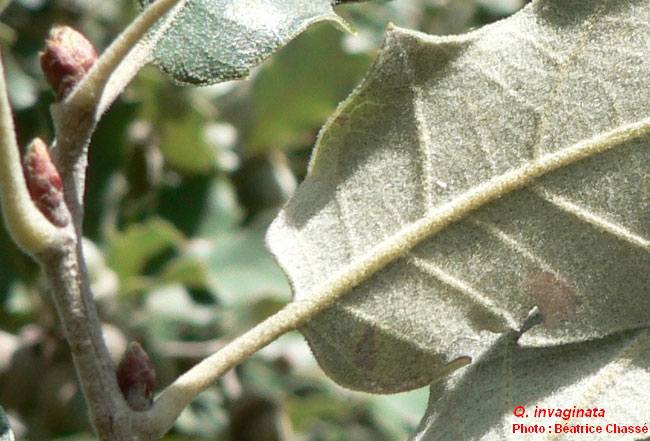| Quercus invaginata | |
| Author |
Trel. 1924 Mem. Natl. Acad. Sci. 20: 87 Diagnosis here |
| Synonyms | invaginata
f. purpusiana Trel. 1924, nom. inval. |
| Local names | |
| Range | Mexico
(Coahuila, Chihuahua, Nuevo Leon, Tamaulipas); 1800-2000 m; |
| Growth habit | shrub
often less than m; |
| Leaves |
2-5
x 1-3 cm; deciduous; leathery, rough; elliptic, oboval or oblong; apex
obtuse or rounded, mucronate; base subcordate, seldom obtuse ; margin
wavy, slightly revolute, with 2-7 pairs of mucronate teeth, seldom entire;
dull green above, withe sparse stalkless fascicled hairs, glabrescent;
paler beneath, with a dense tomentum made of sessile, fascicled, entangled
hairs; |
| Flowers | in May or June; male catkins 2-3 cm long, with numerous flowers; female inflorescences shorter, 0.5-1 cm, with 2-3 pubescent flowers; |
| Fruits | acorn
1-1.5 cm long, 1 cm in diameter; ellipsoid; mucronate; grey at apex; solitary
or 2-3 together on a very short peduncle; enclosed 1/3 to 1/2 by cup;
cup turbinate, scaly, to 2 cm in diameter, with rim rolled inward (invaginate,
hence the name); on the same tree one can find revolute acorn cup, and
not revolute rim; maturing in 1 year in October; |
|
Bark, twigs and |
bark
grey, scaly or furrowed; terminal buds ovoid or globose, with deciduous
stipules; |
| Hardiness zone, habitat | withstands
-16° C; |
| Miscellaneous | -- A. Camus : n° 257; -- Sub-genus Quercus, Section Quercus, Series Leucomexicanae; |
| Subspecies and varieties |
|
| Pictures |
|





